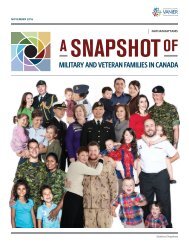1ee0ey1
1ee0ey1
1ee0ey1
Create successful ePaper yourself
Turn your PDF publications into a flip-book with our unique Google optimized e-Paper software.
A HOMELESS HUB RESEARCH PAPER<br />
overrepresented in the child welfare system (Brown<br />
et al. 2007). They may or may not have had a stable<br />
home to begin with, or leave their legally-appointed<br />
care (either voluntarily or involuntarily) for a variety<br />
of reasons. Farris-Manning and Zandstra (2003)<br />
attribute poverty, substance abuse, and inadequate<br />
housing to the over-representation of Aboriginal<br />
children in care of child welfare agencies. Aboriginal<br />
children represent 40 percent of all children in care,<br />
despite the fact that Aboriginal Peoples are only four<br />
to five percent of the Canadian population (Statistics<br />
Canada, 2013).<br />
Fifth, Aboriginal young people may experience<br />
disadvantage and marginalization in unique (and<br />
perhaps more devastating) ways than non-Aboriginal<br />
youth, as one study on Aboriginal Peoples concluded<br />
“cultural discontinuity and oppression...[are] linked<br />
to high rates of depression, alcoholism, suicide, and<br />
violence in many communities, with the greatest<br />
impact on youth” (Kirmayer et al. 2000:607; also refer<br />
to the Role of Historical Trauma section for an overview<br />
of how trauma impacts young people). Furthermore,<br />
Smith et al. (2005) revealed Aboriginal Peoples often<br />
internalized the messages of cultural devaluation<br />
promoted in residential schools, which had a lasting<br />
impact on identity, beliefs, and behaviour. As a<br />
consequence, such individuals frequently suffered<br />
from low self-esteem and negative identity as an<br />
Aboriginal person. This impacted identity and<br />
belonging in future generations, as there was an<br />
active rejection of Aboriginal identity and a lack of<br />
respect for traditional beliefs and practices.<br />
Sixth, the Aboriginal population is the youngest and<br />
fastest growing segment in the Canadian population<br />
(Human Resources and Skills Development<br />
Canada 2013), with Aboriginal youth making up a<br />
much higher proportion of the overall Aboriginal<br />
population when compared to counterparts in the<br />
non-Aboriginal population (28 percent vs. 16.5<br />
percent under 14 years of age; 18.2 percent vs.12.9<br />
percent aged 15 to 24) (Statistics Canada 2013).<br />
Consequently, demographic data signal there may<br />
Aboriginal young people may experience<br />
disadvantage and marginalization in unique<br />
(and perhaps more devastating) ways than<br />
non-Aboriginal youth.<br />
be a substantially higher rate of youth homelessness<br />
within the Aboriginal population in the coming years<br />
(Baskin 2007). This prediction aligns with the research<br />
findings of at least one research team who revealed<br />
youth of Aboriginal descent are overrepresented<br />
within the homeless youth population in several<br />
Canadian cities (Klodawsky et al. 2006).<br />
Finally, Aboriginal Peoples are more likely to be born<br />
with Fetal Alcohol Spectrum Disorder (FASD). The<br />
rate of FASD in Aboriginal communities can be 10<br />
percent or higher, versus about one percent in the<br />
general population (BC Partners for Mental Health<br />
and Addictions Information 2008). FASD can result<br />
in permanent brain damage, learning disorders, and<br />
difficulty controlling one’s temper (Public Health<br />
Agency of Canada 2005). Youths and adults with<br />
FASD are at an increased risk for drug and alcohol<br />
problems, can have difficulty keeping jobs, and can<br />
get in frequent trouble with the law (Public Health<br />
Agency of Canada 2005). These factors can limit<br />
one’s personal relationships, educational attainment,<br />
income and make it more difficult to obtain and<br />
maintain adequate housing. In fact, the Public Health<br />
Agency of Canada (2005) acknowledges that people<br />
with FASD may find themselves homeless because of<br />
these factors.<br />
By the time Aboriginal youth find themselves homeless,<br />
it is likely that many of them have survived extreme<br />
poverty, racism, unsafe or inferior living conditions,<br />
pervasive dysfunction or mental health issues in<br />
families and communities, disconnection from their<br />
birth families and/or child welfare agency placements,<br />
violence, sexual abuse or neglect to varying degrees<br />
early in life. It is also possible they have endured<br />
33





